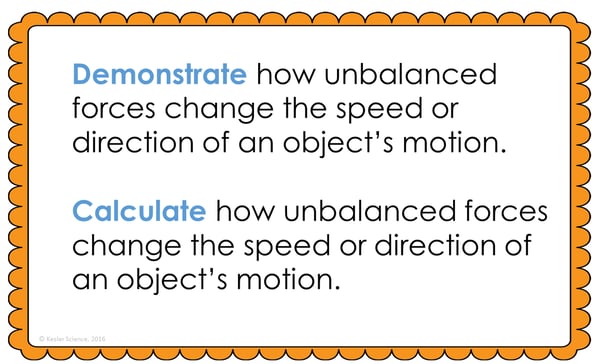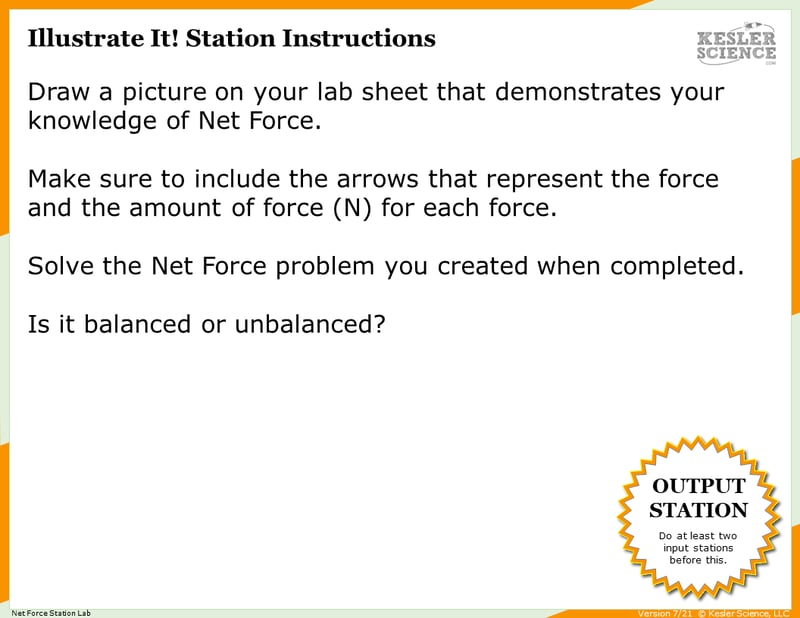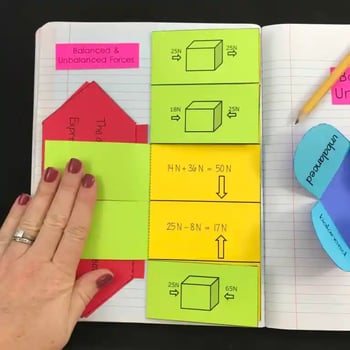Net Force Lesson Plan – A Complete Science Lesson Using the 5E Method of Instruction
By the end of this lesson plan about net forces, students will be able to demonstrate how unbalanced forces change the speed or direction of an object’s motion, as well as calculate how unbalanced forces change the speed or direction of an object’s motion. Each of our lessons is designed using the 5E method of instruction to ensure maximum comprehension by the students. This well-thought out unit does the heavy lifting, giving teachers easy-to-implement, highly engaging lesson plans.
The blog below will walk you through each of the steps and activities from the Net Forces 5E Lesson Plan.
ENGAGEMENT
Objective Introduction
At the beginning of the lesson, the class will do a Think-Pair-Share to discuss the objective.
Class Activity
Review the concepts of balanced and unbalanced forces. Emphasize balanced forces are at rest or at a constant speed and direction. Unbalanced forces cause a change in position, direction, and speed.
Student Activity
- Choose five equally sized students to participate in an easy tug-of-war game. Give each of them a sign that indicates their force is 10N. Place 3 people on one side of the rope and two on the other. Mark a line over which they need to pull the other team. Do the tug-of-war.
- Ask the students questions:
- Is this an example of a balanced or unbalanced force?
- In what areas did you see a change: (position, direction, or speed)
- Explain that the overall force on an object is called the net force. See if they can come up with a way to calculate net force before giving them the answer. (30N-20N=10N) Emphasize that forces going in opposite directions are always subtracted.
- Give students different force numbers (signs). Repeat a couple times with different size students and assign them a different force. Each time calculate the net force.
- Give students different force numbers (signs). Have them demonstrate forces that push against each other by having them push on opposite sides of a chair or desk. Calculate the net force.
- Give students different force numbers (signs). Have them demonstrate forces that move in the same direction. Have two students move a cart or a desk. Emphasize that forces going in the same direction are always added together.

The teacher will help to clear any misconceptions about net forces. A major misconception is that students think that forces are always subtracted even if they are going in the same direction. This is partially true but doesn’t tell the whole story.
Estimated Class Time for the Engagement: 20-30 minutes
EXPLORATION
This student-centered station lab is set up so students can begin to explore net forces. With nine stations in total, you can introduce the concept of net forces to your middle school students in a variety of ways! Four of these stations are considered input stations where students will learn new information about net force, and four of the stations are output stations where students will be demonstrating their mastery of the lesson's material. A bonus station offers challenges for your early finishers and independent learners. You can read more about how I set up the station labs here.
Watch It!
At this station, students will be watching a short video explaining net forces. Students will then answer questions related to the video and record their answers on their lab station sheet. For example: What do you have to do with the forces when the arrows are in the same direction? What do you have to do when the arrows are in different directions? Calculate the net force problem above and determine the direction it will travel.
Read It!
This station will provide students with a one-page reading about net forces. Students will also learn about how physics and the application of forces can be found all around, even in a sport like soccer. There are four follow-up questions that the students will answer to demonstrate their comprehension of the reading material.
Explore It!
Students will be working in pairs to better understand net force. In this station, students manipulate objects as they conduct certain tasks and record their movements using a prescribed force amount. Students will follow the steps and record their observations on their lab sheet.
Research It!
The research station will allow students to explore an interactive web page that helps them to understand net forces in a PheT tug-of-war simulation. Students will follow the instructions from the task cards that will show how an unbalanced force will cause the cart to change direction and speed of the net force if not at zero. Students will be instructed to complete a few tasks and record answers on their lab sheets.
Organize It!
Students at this station will match the calculated net forces of four different scenarios. Once students have completed their organization, the teacher will check their understanding.
Illustrate It!
Your visual students will love this station. Students are to draw a picture that demonstrates their knowledge of net forces. They will need to label the drawing including the arrows and the forces being applied in each direction. Students will also calculate the net force that they are illustrating.

Write It!
Students who can answer open-ended questions about the lab truly understand the concepts that are being taught. At this station, the students will be answering three task cards: Describe how to calculate a net force problem when the forces (arrows) are in the same direction. Describe how to calculate a net force problem when the forces (arrows) are in the opposite directions. Describe what net force is.
Assess It!
The Assess It station is where students will go to prove mastery over the concepts they learned in the lab. The questions are set up in a standardized format with multiple choice answers. Some questions include: Net force can be described as _________. What is the net force of the rocket? What is the net force of the boat? What is the net force of the box?
Challenge It! - Bonus Station
Early finishers and advanced students will love the extension activities in this station. Four activity choices offer them ways to expand their learning through mini-games and mini-projects.
Estimated Class Time for the Exploration: One or two 45-minute class periods
EXPLANATION
The explanation activities will become much more engaging for your class once they’ve completed the exploration station lab. During the explanation piece of the lesson, the teacher will be clearing up any misconceptions their students may have about net force with a variety of materials. These materials include on-level and modified versions of the interactive presentation (may be used individually or projected), anchor charts, and paper or digital interactive notebook activities. If you have students that need modified notes, the 5E lessons come equipped to help give every student access to the lesson.

Interactive notebook samples: Above-left is a digital INB activity slide; above-right is an example of the paper INB activities.
The students will also be interacting with their journals while taking notes from the PowerPoint. If you have students that need modified notes, the 5E lessons come equipped to help give every student access to the lesson.
Estimated Class Time for the Exploration: Two or three 45-minute class periods
ELABORATION
The elaboration section of the 5E method of instruction gives students choices that allow them to prove they’ve mastered the concepts behind the lesson. When students are given a choice, they’re much more enthusiastic and invested in the project than they are when their teachers choose their projects for them. There are a total of nine choices to demonstrate understanding of net force. A separate set of choices that offer more teacher support are also available for students that need them. Rubrics guide students to doing their best work and assist in grading.

Estimated Class Time for the Elaboration: Two or three 45-minute class periods (can also be used as an at-home project)
EVALUATION
The final piece of the 5E model is to evaluate your students' comprehension. Included in every 5E lesson is a homework assignment, assessment, and modified assessment. Research has shown that homework needs to be meaningful and applicable to real-world activities in order to be effective. When possible, I like to give open-ended assessments to truly gauge the student’s comprehension.
Estimated Class Time for the Elaboration: One 45-minute class period
DOWNLOAD THE FULL LESSON NOW
Download Over $100 in FREE Resources
For Middle School Science
Simply create a login below and gain immediate access to a selection of our Kesler Science product line worth $100 - for FREE. There's a full version of every product type! You'll also join tens of thousands of middle school science teachers who receive timely tips and strategies straight to their inbox.







